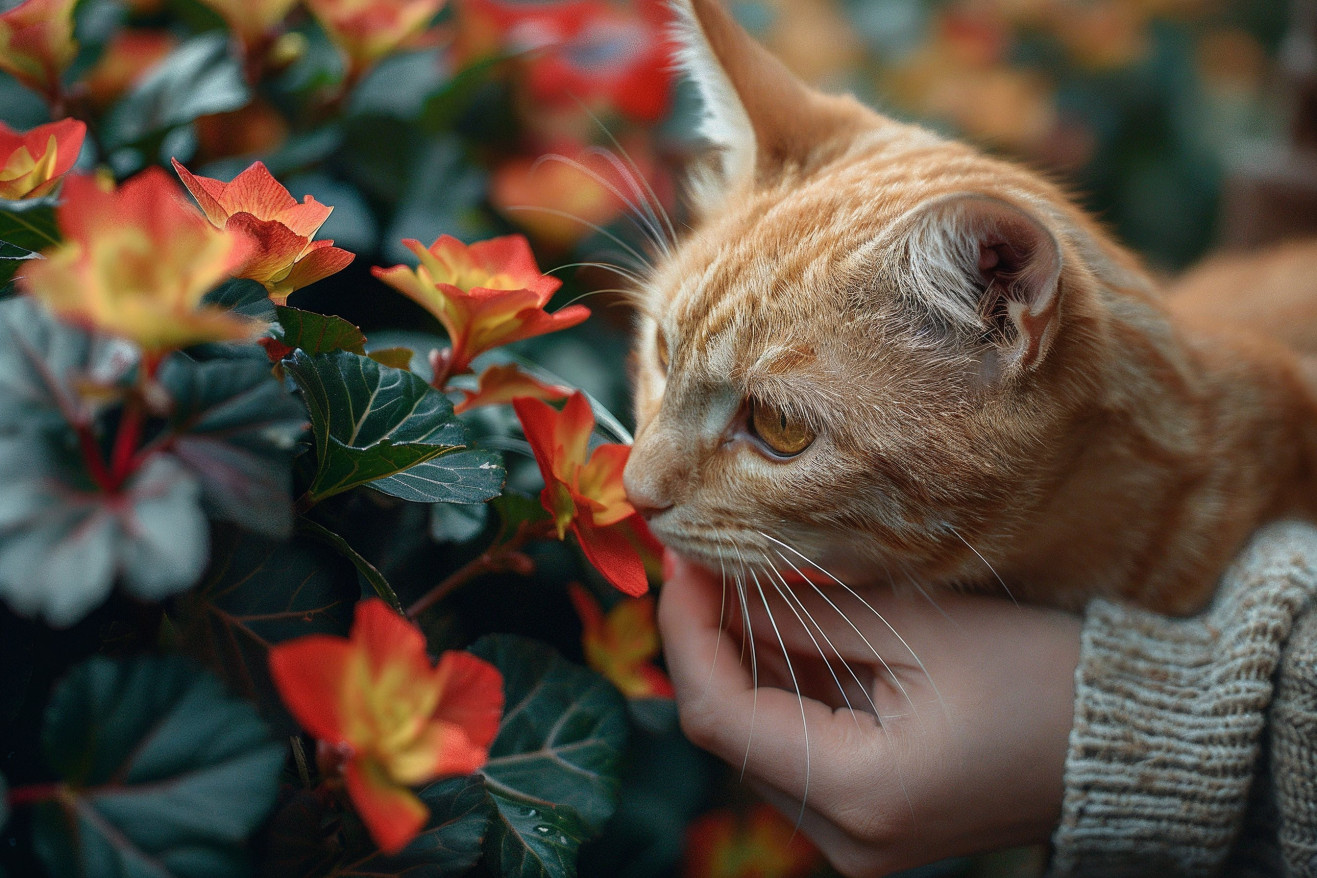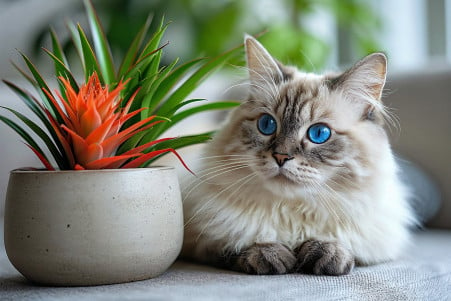Can Cats Eat Begonias? A Complete Safety Guide
1 April 2024 • Updated 30 March 2024

As is the case with many other popular indoor plants, begonias can be toxic to cats if they decide to take a bite out of the leaves or stems. Begonias contain insoluble calcium oxalate crystals, which can lead to oral irritation, drooling, vomiting, and difficulty swallowing in cats that have ingested them. Although toxicity is usually low to moderate, it's a good idea to keep begonias in a place that's not accessible to your cats.
To give you a complete picture of this potential danger, we've looked at information from vets, plant toxicology research, and real-life examples of cats being exposed to begonias. By bringing all of this information together, you'll be able to walk away with actionable information that will help you keep your cats safe while still incorporating these beautiful plants into your home responsibly.
Are begonias poisonous to cats?
What Makes Begonias Toxic: Compounds and Plant Parts
The toxic agent in begonias is soluble calcium oxalates, which can lead to hypocalcemia and kidney failure if cats ingest large amounts, according to the ASPCA's toxic plant database. The highest concentration of these oxalate crystals is found in the underground parts of the plant, including the roots and tubers, which is why they are considered the most toxic parts of begonia plants.
That said, the aboveground parts of the plant, including the leaves and stems, can also cause oral irritation, drooling, vomiting, and gastrointestinal upset if cats eat them, according to a post about Polka Dot Begonia toxicity on Greg, a plant care app. In addition, different types of begonias may have different levels of soluble oxalates, with some species, such as Polka Dot Begonia (Begonia maculata), potentially being more toxic than others.
As a result, knowing the specific type of begonia your cat has been exposed to can help determine the potential severity of the toxicity and, in turn, the best course of treatment, according to the ASPCA. Given this information about the compounds and plant parts involved in begonia toxicity, cat owners can make sure they are taking the right steps to prevent their cat from being poisoned by begonias.
How to Avoid Begonia Poisoning: Realistic Safety Tips
To avoid begonia poisoning, it's important to keep these plants in high places where your cat can't reach them. As mentioned in the Looking Glass Cane Begonia care article, putting begonias on high shelves or hanging them will keep them out of your cat's acrobatic reach.
In addition, taste deterrents like citrus peels or cayenne pepper can be placed around the base of the plant to keep cats away from it, according to the Cocktail™ Vodka Begonia care article. You can also use pet-safe repellent sprays to keep cats away from your plants.
In addition, you can distract your cat from your begonias by providing cat-safe plants like cat grass or catnip in another area of your home, as noted in Preventive Vet's guide on keeping cats out of houseplants.
You can also keep cats away from begonias by using baby gates or closed terrariums to keep them away from your plants. Other tips include checking your plants for signs of damage or consumption, and covering the soil with stones or mulch.
These realistic safety tips will help you enjoy your begonias while keeping your cats safe. However, if your cat does eat your begonias, it's important to get them to the vet right away.
Treatment and Recovery of Begonia Poisoning in Cats
If a cat eats any part of a begonia plant, the first step is to wash out their mouth with water, according to the guide on Begonia poisoning from Paws Dog Daycare. After that, owners should watch for signs of poisoning, such as vomiting, drooling, and difficulty swallowing, and then call a vet immediately, according to the experts at Hepper.
Owners should not try to induce vomiting or give the cat any at-home treatments, as these can make the situation worse, according to the wikiHow guide on treating a poisoned cat. Treatment from a vet may involve IV fluids, anti-inflammatory medications, and other supportive treatments to help the cat deal with dehydration and pain, according to the information from JustAnswer.
In most cases, cats will recover from mild begonia poisoning within 48 hours if they receive treatment and care from a vet, according to the Hepper article. However, the sooner the cat receives care and treatment, the better the outcome, so cat owners should make sure to call a vet as soon as they realize that their cat has eaten a begonia.
Begonia Types: Which Ones Are Safe and Poisonous?
Although most begonia types contain oxalates, some begonia cultivars like the Strawberry Begonia are safe for cats. The Strawberry Begonia, also known by its scientific name Saxifraga stolonifera, does not contain the harmful calcium oxalates that are present in other begonias, so it is safe to keep in homes with cats.
Meanwhile, the ASPCA's database of toxic plants lists Polka Dot Begonias and Rex Begonias as some of the most poisonous begonia types due to their high oxalate content. The easyplant guide on toxic plants also warns that the popular houseplant Begonia Maculata, which is known for its unique spotted leaves, can be toxic to pets if they eat enough of it.
When bringing new begonia plants into the home, it's important to look up the specific type to determine whether it may be toxic to cats. As the LifeLine Animal Project notes, it's important to use caution with "safe" plants as well because they can still be dangerous if they are eaten. However, with careful consideration and selection of begonia types, cat parents can bring these beautiful plants into their homes while keeping their cats safe and healthy.
Conclusion: How to Safely Keep Begonias Around Cats
As per the Argos Pet Insurance guide, begonias can cause intense burning and irritation in the mouth if eaten by dogs or cats. Ingestion will also lead to excessive drooling, vomiting and possibly make your pet have difficulty swallowing.
The Tuberous Begonia toxicity guide goes on to say that the roots and tubers of begonias are the most toxic parts of the plant due to the highest concentration of harmful calcium oxalates. While most cases of poisoning result in mild symptoms like oral and stomach irritation, more severe cases can result in kidney failure or damage to the esophagus.
If a cat eats any part of a begonia, it's important to get them to a vet immediately to prevent more serious health issues. The vet may treat the cat with activated charcoal or gastric lavage. However, it's best to avoid this situation altogether by keeping begonias out of reach, using deterrents, and offering cat-friendly plants instead—steps that are necessary to enjoy begonias safely around cats.


